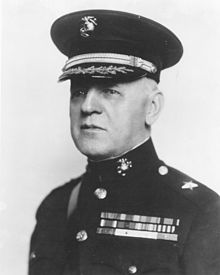Dion Williams
| Dion Williams | |
|---|---|

Brigadier General Dion Williams
|
|
| Nickname(s) | Father of Marine amphibious reconnaissance |
| Born |
December 18, 1869 Williamsburg, Ohio |
| Died | December 11, 1952 (aged 82) National Naval Medical Center, Bethesda, Maryland |
| Buried at | Arlington National Cemetery |
| Allegiance |
|
| Service/branch |
|
| Years of service | 1893–1934 |
| Rank |
|
| Commands held |
10th Marine Regiment 2nd Provisional Marine Brigade 4th Marine Regiment Assistant Commandant of the Marine Corps |
| Battles/wars |
Battle of Manila Bay Spanish–American War |
| Awards | Navy Distinguished Service Medal |
Brigadier General Dion Williams (December 15, 1869 – December 11, 1952) was an officer in the United States Marine Corps. He was the Assistant Commandant of the Marine Corps from August 1, 1925 — July 1, 1928. During his early career, Williams pioneered the first conceptual study of amphibious reconnaissance in the United States and becoming one of the strongest advocates in having the Marine Corps assume the amphibious, expeditionary role. During his career, he fought guerrillas in the Philippines and Dominican Republic during the Spanish–American War.
Williams is credited in the persuasion of Admiral Dewey in 1907 to assert Congress that "a force of 5,000 Marines with a Fleet" would have ensued the Philippine–American War following the Spanish defeat. This 'force' was the first of the doctrinal sequence of the establishment of the Advanced Base Force, its titulage American Expeditionary Force and subsequently its modern namesake, Fleet Marine Force.
Williams retired from the Marine Corps in 1934, spending the rest of his life in Maryland.
Dion Williams was born in Williamsburg, Ohio on December 15, 1869.
On June 30, 1891, he graduated from the United States Naval Academy.
After completing the required 2-year sea duty aboard the USS Atlanta as a midshipman, he was commissioned a 2nd Lieutenant in the United States Marine Corps on July 1, 1893. He attended the School of Application before he served at the Marine Barracks, New York and the Marine Barracks, Mare Island until 1897.
...
Wikipedia
